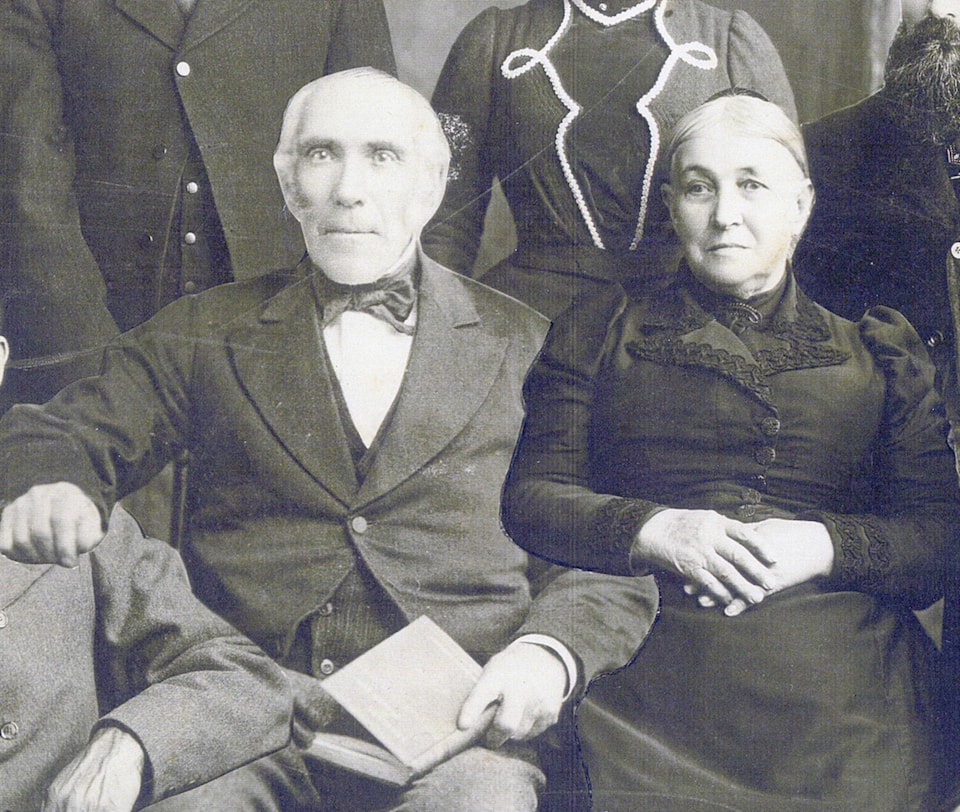The original dwelling on the McCleary homestead was a log building with a loft under the roof that served as sleeping quarters; it was accessible by a ladder. As John’s family increased in numbers additions had to be made.
The first child born to 15-year-old Catherine was a boy named Samuel, who joined the household on December 20, 1847. He was followed by the future wanderer and Castlegar pioneer, Albert, on July 3, 1849. Mary Jane arrived on April 15, 1851, followed by Harriet Anne on May 21, 1853. Another boy, John, was born on August 13, 1854. More girls were born: Eliza Victoria (February 1, 1857), and Martha Matilda (June 9, 1858). The last boy, Robert George, arrived on February 27, 1860. A second Martha Matilda replaced the first (who died on March 22, 1860) on October 9, 1861. The last child born was Susan Merinda (May 9, 1863). She also died young, at age two, on February 9, 1865.
It must have been a crowded household as the children were growing up. For most of them, their grandmother Jane was there to help out with the rearing. She was a capable woman until her health started failing, and she died of congestive heart failure in 1860. With her passing, an era came to an end:
Her lifetime speaks of a quiet inner strength. It speaks to an acceptance of a life that was rife with oppression, warfare, poverty and disease. Jane endured and survived through it all.
As the children were arriving John was working hard to improve the land and bring more of it under cultivation. He added new crops: peas (7 acres), Indian corn (1 acre), potatoes (1 acre), and a quarter acre of turnips. Sheep were useful additions to the livestock, as were pigs. The farm also produced some hundred pounds of maple sugar from trees native on the land. Dartford was the nearest village where the necessary groceries could be obtained.
The children attended school, located about a mile from home. They also helped with various chores at home, and as they approached maturity their contribution to the management of the farm increased. The household population was reduced somewhat when the girls married and moved away.
Mary Jane married in 1869, Martha Matilda in 1883, and Eliza Victoria in 1885. Harriet remained single, as did John and Albert, although the latter left the farm around 1872. By the time his last child was born, John was starting to feel the effects of a lifetime of hard work and repeated childrearing. Martha sensed this, as there appeared to be a distance between her father and herself, which was instead bridged by her eldest brother Samuel, who was more of a father figure to her. He remained a bachelor until he married Eliza Brisbin in 1880. The couple stayed on the farm, and their own children again contributed to the population. Robert married Mary Curtis in 1886, and the couple moved to Warkworth to start a family.
John Senior, feeling his strength fading and the end approaching, drew up a will in August 1882. In it, he left the southern 100 acres of the farm to Samuel and the northern half to John. Robert George was to receive an equivalent share in cash, which amounted to $2,000. The three yet-unmarried daughters would receive $200 each, with half being contributed by their land-owning brothers. Mary, the one married daughter, would receive half the share allotted for her single sisters. John did not know what to do about Albert, having lost all contact.
In his initial will, he left him the same allotment ($200) that went to his single daughters, except that the sum was to be payable by his land-owning sons. As time progressed, his disillusionment with Albert’s seeming uncaring attitude grew. His trips to the mailbox became more frequent, in the hope of finally receiving a letter from his wayward son. None arrived, and in September 1883 he amended his will and revoked his bequest to Albert. In February 1885 he made one more alteration to his will, adjusting it for the two daughters that had married since 1882 to the same terms as for his one then-married daughter in the original will. By this time he was suffering from the effects of heart disease, which ended his life on May 23, 1885. Caroline, 22 years younger, outlived him by 18 years, passing away at the home of Eliza on March 22, 1903.
This is the second part of the history of the McCleary’s, based on the book Ireland to Canada: The John McCleary Story, by George McCleary.
